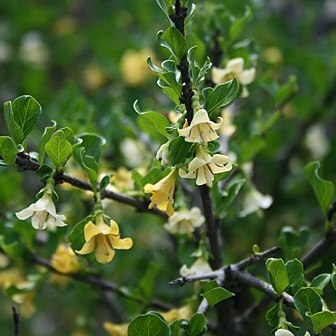Leaves 0.8–5.5 × 0.3–3.3 cm, elliptic to almost round, usually obtuse or obtusely acuminate at the apex, cuneate and contracted into the petiole, thin in texture, ± shortly pubescent on midrib above, with hairy domatia in leaf axils beneath or ± densely shortly bristly pubescent on both surfaces; true petioles short, rarely up to 1 cm long together with the narrowed leaf base, ciliate; stipules 1–2 mm long, pubescent, the persistent bases rendering the short shoots nodular.
Inermis v. ramulis glabris virgatis apice spinescentibus, foliis (parvis) fasciculatis obovatis v. ellipticis obtusis basi cuneatis glabris v. subtus subtilissme puberulis brevissime petiolatis, pedunculis unifloris axillaribus calyce brevioribus ebracteatis, calycis tubo obconico glaberrimo laevi, laciniis obovatis obtusis, corollae glabrae tubo infundibuliformi subexserto, limbo erecto-patente, laciniis oblongis planis, antheris linearibus elongatis.
A shrub. It can grow 2.5 m high. It has many branches. Young branches are grey. They often arch over. The leaves are small and shiny. They are in clusters on opposite sides of the stem. They are 2 cm wide and 2.5 cm long. The flowers are small and bell shaped. They are 10-15 mm across. They are white. The fruit are greenish-brown and round. They are 8 mm across.
Shrub, 1.0-2.5 m high. Corolla tube developed with upper funnel-shaped part and lower cylindrical part. Style narrowly clavate, winged at apex. Anthers apiculate. Fruits small, seeds compressed ovoid-angular, not in a pulp. Flowers white, cream or yellow.
Calyx glabrous to pubescent; tube 1–2 mm long; limb-tube 1–1.5 mm long; lobes 0.5–1.5(2.5) mm long, persistent in fruit.
Corolla white or cream-coloured turning dark yellow, glabrous outside; tube 5–7 mm long; lobes (3)4–6 × 1.7–2.5(5.5) mm.
Fruit 5–7 mm long and wide, ellipsoid to ± subglobose, glabrous or slightly to densely setulose or pilose.
Anthers mostly included, the tips exserted for 2 mm; pollen presenter exserted for 5–6 mm.
Shrub 1–2.5 m or tree to 4 m tall, unarmed, much-branched; young branches grey, pubescent.
Pedicels 1–2 mm long, sometimes lengthening to 4–5 mm in fruit.
Seeds pale chestnut-coloured, c. 2.5 × 1.8 × 0.7 mm.

